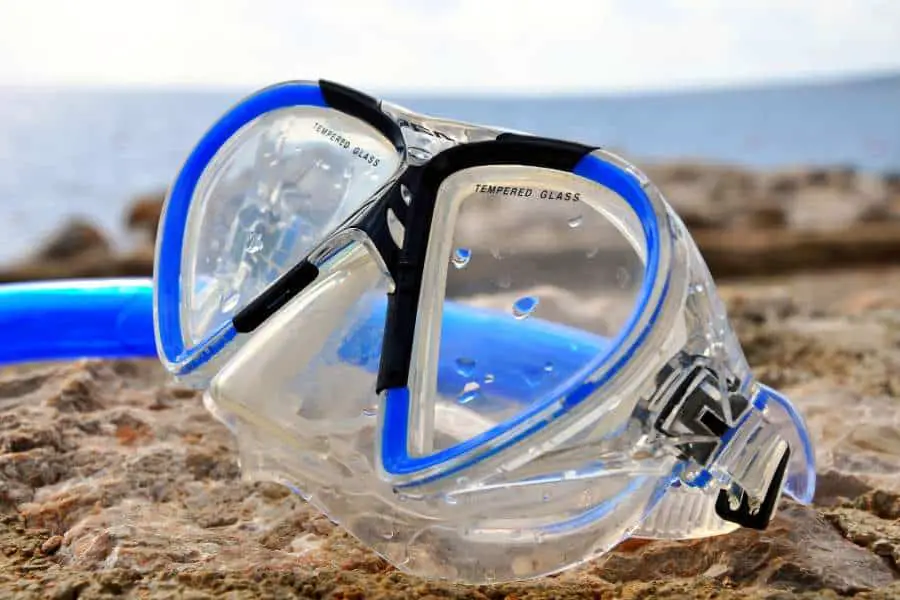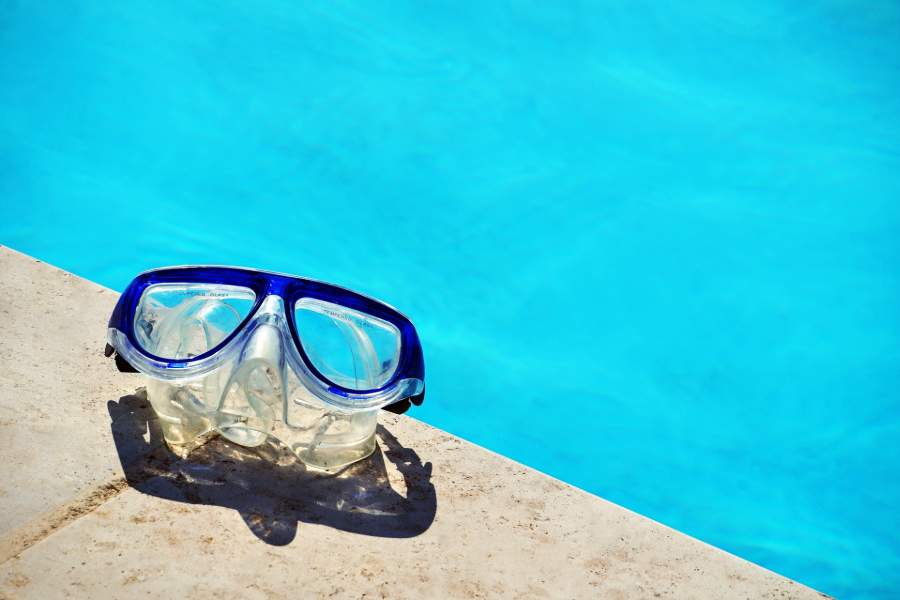As an Amazon Associate we earn from qualifying purchases.
Snorkel and Scuba masks are quite a challenge when cleaning, as it requires special attention and care to avoid any damage and prevent them from fogging up. Learn how to clean your snorkel mask so you can see clearly and it doesn’t fog up.
Contents
How to Clean a Snorkel Mask
Fogging is one of the main challenges faced with a snorkeling mask. Thus the cleaning methods will specifically target it for a better user experience at the beach. The cleaning methods discussed in the article are simple and involve materials that are easily available at home.
Materials Required
Here is the combined list of materials you will need for each of the methods presented in this article.
- Toothpaste
- Microfiber cloth
- Warm water
- Baby Shampoo
- A spray bottle of anti-fog solution
While you’re cleaning your mask, spend a few extra minutes and clean all of your snorkel gear.

Method 1: Cleaning A Snorkel Mask With Toothpaste
Dirt is one of the major reasons behind the fogging up of your snorkel masks, as water loves the cozy environment due to dirt and sticks to the glass.
Hence, cleaning a snorkel mask with toothpaste can help you with the fogging. Here is the step-by-step guide:
- Start with putting just a little bit of toothpaste both on the inside and outside the lenses (use a couple of dabs, not more than that).
- Now take a microfiber cloth and gently scrub the inside and the outside of the lenses. If you do not have a microfiber cloth, use a soft towel and do not scrub too hard.
- Make sure your fingers do not touch the glass, as they have a certain amount of natural moisture in them. Do not use a brush for scrubbing as well. It can cause scratches that can worsen the fogging.
- Once the mask is lightly scrubbed, rinse the lens with warm water to remove the toothpaste thoroughly.
- Now take a microfiber cloth, use the unused part of the earlier one and clean the lenses dry.
- If your mask is dirty, it might take more than one round to make the lenses spotless.
Toothpaste is one of the magic cleaners, they can also be used in cleaning cymbals, and also has a few soothing properties in case of acne. Moreover, it is gentle and hardly has any side effects because of its mild properties.
Method 2: Applying an Anti-Fog Spray to the Inside
If you want to win this fogging war, this step is necessary to follow. Once the cleaning is done, you need to move forward with applying an anti-fog spray to the inside of the snorkel mask.
Here are the step by step instructions:
- The most pocket-friendly way of going around this step is to mix a little bit of baby shampoo with clean water. Make sure to mix five parts of baby soap and one tablespoon of water.
- Apply this mixture to the inside of the snorkel mask.
- The best method to put an even coat of the mixture is by using a spray bottle. So, put the mixture into the spray bottle and spray an even coating of the mixture on the lenses.
- If you do not have a spray bottle, go with putting a little bit of solution directly on the mask and move it around to spread it equally on each side.
- Once the spreading is done, clean the lenses dry with a soft and clean microfiber cloth for the best results.
- Do not use the anti-fog solution outside the lens, as the fog is not accumulated on the outside, and avoid touching the lenses with fingers due to natural oils.
After using this method for cleaning your snorkel mask, you are all set up to make as many dives as you want. Here is the link to a video guide for cleaning the snorkel mask when you run out of anti-fog spray.

Method 3: Do Not Forget to Rinse Your Mask After Every Snorkel
The best advice you can get regarding cleaning and maintaining a snorkel mask in the ocean or beaches is not to forget to rinse your mask after every snorkel.
This advice goes for everything you wear, like swimsuits, action cameras, wet suits, etc.
- Do not forget to use fresh water to rinse off all the extra dirt particles from your snorkel after each dive.
- If you avoid regular rinsing, the dirt and the salt from the ocean and beaches will degrade the plastic and silicone parts of the mask, thus resulting in the premature aging of the material.
- If the advice is avoided, your mask seals and adjustable straps will be compromised, thus do not forget to give a good rinse after each dive.
- This advice is also valid for full-face snorkel masks.
- After every dive, make sure you focus on the lenses, adjustable straps, the frame, and the silicone skirts of the mask.
Here is the link to a study highlighting the use of the snorkeling mask during the pandemic.
Things You Need to Know Before Buying a Snorkeling Mask
If you go regular dives, you might have explored some anti-fogging products in the market, but they are quite expensive and may not hold that value when it comes to quality.
Here are a few things that you need to know before buying a snorkeling mask so that you can make a fair choice.
- Try to go for a home-based DIY to save you some money because even if the spray works, it might not be that good at the ocean.
- Try to give the baby shampoo technique a shot, as it has active agents in it that can remove the dirt easily, and its mild properties do not cause the lenses any harm, this is also effective in cleaning sheepskin seat covers.
- If you are still moving forward with buying an anti-fog spray, make sure that it is reef safe because it is friendly to marine life.
Since marine life is suffering from man-made objects, make sure that you use reef-safe sunscreens and eco-friendly products for sustainable and eco-friendly diving.
Ways to Keep Your Mask Fog-Free During Snorkeling
We have discussed the cleaning mechanisms that keep the snorkeling masks fog-free, but what about the fogging during snorkeling.
Here are a few tips and tricks to keep your mask for free during snorkeling.
- Do not keep your snorkeling mask in the sun before going for a dive, as it gets heated in the sun, and when it enters a cooler environment, the warm air begins to condense and start to fog on the inner sides of the lenses.
- Even if, after all the efforts, you still end up getting some fog on the glasses, the best method to go about this is using your saliva.
- Take out your, ask and spit on the lenses and rub, it might seem a bit gross, but this method is effective as it repels condensation.
Fogging can ruin the whole diving experience, thus practicing these easy tricks during your next trip to the ocean or beach for a great diving experience.
How to Clean the Snorkel Tube?
In the aforementioned methods, most of the attention is given to lenses and silicon parts of the mask. Now it is time to learn how to clean the snorkel tube for the best diving experience:
- Cleaning it is pretty easy; start running some clean water through the tube to remove any dirt or sand from the tube.
- If the tube is dry, make sure you run the water through a mouthpiece and ensure the tube is rinsed well.
- Now put some antibacterial soap through the mouthpiece, do not use anything with strong chemical properties.
- Now rinse off with some clean water, and voila, your tube is completely clean.

Frequently Asked Questions
What Precautions Should I Take With a Snorkeling Mask?
Make sure your snorkeling mask does not have any contact with the sand, as it can form scratches on the lenses and compromise the quality of the mask. Even if the sand somehow sticks to the surface, do not press it too hard; just rinse it with some water.
Why Are There 3 Different Sizes of Snorkel Masks?
The snorkel masks cover at least 80% of the face. Thus, it is essential to have three different sizes for a better fit. The XS size fits well for the children. The S/M size fits well for women and children above the age of 10, and the M/L size fits well for an adult male.
Conclusion
If your snorkel mask is dirty or greasy, it can ruin your exciting plans at the ocean or beach. The above-mentioned methods hardly take a few minutes of your time and make sure that you have a memorable diving experience this summer. Snorkeling masks are delicate when it comes to maintenance; thus, make sure you handle them with care so that the quality is not compromised.
